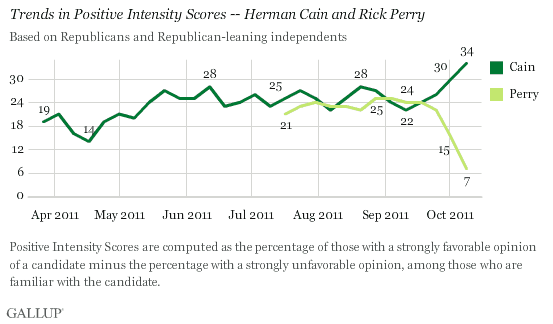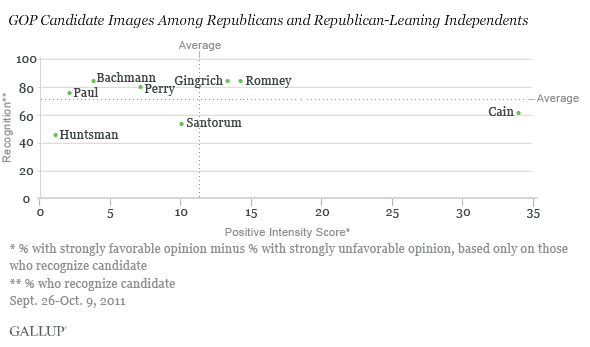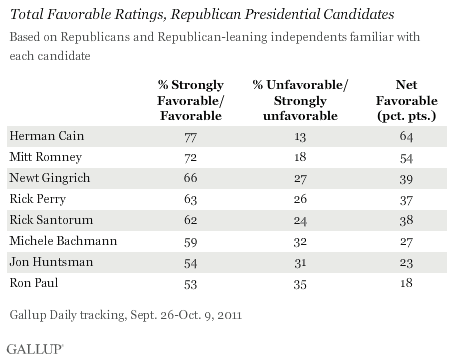PRINCETON, NJ -- The upward trend continues in Republicans' ratings of presidential candidate Herman Cain, as does the downward trend in their ratings of Rick Perry. Cain's Positive Intensity Score has increased to 34 among Republicans familiar with him, while Perry's has dropped to 7 in Gallup's latest update. Cain's score is the best any candidate has registered during the campaign this year.

The results are based on Gallup Daily tracking from Sept. 26 through Oct. 9. Cain and Perry have typically been among the leaders in positive intensity since Gallup began tracking their images, but their scores have diverged dramatically in recent weeks. The movement occurred after Cain's win in the recent Florida straw poll and a series of shaky debate performances by Perry. Perry's policies on illegal immigration may also have contributed to his decline.
The changes in Cain's and Perry's images have left Cain as the dominant leader in positive intensity -- the difference between strongly favorable and strongly unfavorable opinions of each candidate among Republicans familiar with the candidate.
Mitt Romney (14) and Newt Gingrich (13) now come closest to Cain in positive intensity; Rick Santorum (10) is the only other candidate Gallup tracks who is in double figures.
Cain still is not as well-known as his rivals for the nomination, though his 61% name recognition among Republicans and Republican-leaning independents is up from 51% two weeks ago. Most other candidates are known by at least three in four Republicans.

Romney Well-Liked, but Not as Intensely as Cain
The Positive Intensity Score measures the strength of Republicans' liking of the various presidential candidates. But from a broader perspective, Republicans have a more positive than negative view of all candidates.
When intensity is not taken into account, Cain has the highest net favorable rating of the candidates at 64, with Romney in second at 54, among those familiar with each -- a much smaller gap between the two than the 20-percentage-point gap in their Positive Intensity Scores.

Cain's total favorable rating of 77% is five points higher than Romney's 72%, suggesting the two are about equally well-liked among Republicans familiar with them. What separates the two, as evidenced by their Positive Intensity Scores, is the intensity those who like Cain feel toward him. Thirty-five percent of Republicans familiar with Cain have a strongly favorable opinion of him, compared with 18% for Romney.
When Gallup last looked at total favorable ratings, in late August/early September tracking, Perry (73%), Cain (73%), and Romney (71%) essentially tied for the top. Republicans now view Perry less favorably and Cain slightly more favorably, though the intense positivity toward Cain has picked up.
Implications
Cain's recent surge in positive intensity has been matched by a rise in his standing in Republican nomination preference polls, in which he now essentially ties Romney for the lead. Cain's new status as a leading contender for the nomination could lead to increased attacks on his record by his GOP rivals. Perry and Michele Bachmann saw their formerly strong positive images decline after coming under increased scrutiny by the media and their rivals in debates.
If Cain is unable to sustain his strong positive image over the next several months, it could leave Romney in an advantageous position for the nomination as the most well-liked, even if not the most loved, Republican presidential candidate.
Survey Methods
Results are based on telephone interviews conducted as part of Gallup Daily tracking Sept. 26-Oct. 9, 2011, with random samples of Republicans and Republican-leaning independents, aged 18 and older, living in all 50 U.S. states and the District of Columbia. Questions asking about the eight candidates measured in this research were rotated among randomly selected samples of Republicans each night; over the 14-day period, each candidate was rated by approximately 1,400 Republicans and Republican-leaning independents.
For the overall ratings of each potential candidate among Republicans and Republican-leaning independents, including recognition scores, one can say with 95% confidence that the maximum margin of sampling error is ±3 percentage points. For the Positive Intensity Score for each candidate, the maximum margin of sampling error varies depending on the size of the group recognizing the candidate.
Interviews are conducted with respondents on landline telephones and cellular phones, with interviews conducted in Spanish for respondents who are primarily Spanish-speaking. Each sample includes a minimum quota of 400 cell phone respondents and 600 landline respondents per 1,000 national adults, with additional minimum quotas among landline respondents by region. Landline telephone numbers are chosen at random among listed telephone numbers. Cell phone numbers are selected using random-digit-dial methods. Landline respondents are chosen at random within each household on the basis of which member had the most recent birthday.
Samples are weighted by gender, age, race, Hispanic ethnicity, education, region, adults in the household, and phone status (cell phone only/landline only/both, cell phone mostly, and having an unlisted landline number). Demographic weighting targets are based on the March 2010 Current Population Survey figures for the aged 18 and older non-institutionalized population living in U.S. telephone households. All reported margins of sampling error include the computed design effects for weighting and sample design.
In addition to sampling error, question wording and practical difficulties in conducting surveys can introduce error or bias into the findings of public opinion polls.
For more details on Gallup's polling methodology, visit www.gallup.com.
